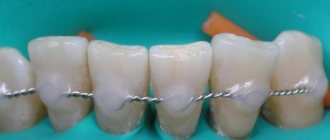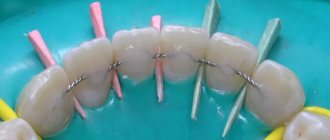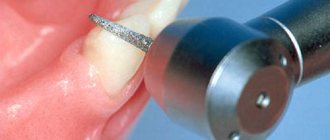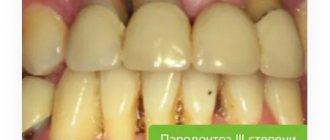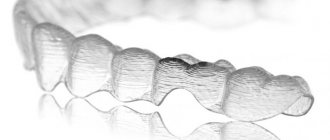27.01.2020
Dear readers, we have prepared an interesting article for you - a review about teeth splinting and answers to related questions. From this material you will learn:
Teeth splinting - what is it? Indications for using the splinting technique; splinting of mobile teeth; what techniques are used; what materials are used; how much does the procedure cost?
WHY ARE TEETH SPLINTED?
We collected the main indications for this procedure and came up with five points:
- With a non-standard direction of tooth growth.
- In case of displacement of teeth in a row.
- For chronic periodontal diseases that cause bleeding.
- In cases where a large amount of deposits accumulate around the tooth root, which can lead to its destruction and tooth loss.
- The presence of deep gum pockets, the appearance of which has led to significant exposure of the roots of the teeth.
Splinting requirements
Splinting is performed correctly under the following conditions:
- tooth mobility is limited in all directions;
- the splint provides high strength and reliable fixation to the teeth;
- it has a minimal traumatic effect on the marginal periodontium and hard tissues;
- provides free access to the periodontal sulcus;
- there are no retention points in the design where food could accumulate;
- a harmonious functional occlusion has been formed;
- the tire looks aesthetically pleasing and is capable of transformation and restoration.
SPLINTING FOR PERIODONTITIS, PERIODONTOSIS, DENTAL INJURIES
Periodontal disease is one of the most common problems dentists encounter. Therefore, among the “top” reasons is splinting teeth for periodontitis – an inflammatory disease of periodontal tissue. This disease causes the roots to become exposed. Teeth begin to become loose, which can ultimately lead to tooth loss.
The main task is to strengthen teeth that are starting to become loose. Moreover, it is important to do this at the initial stage. There are several solution options - high-strength fiberglass threads, prostheses, etc.
Often, patients consult a doctor only when the disease is chronic and reaches a moderate or even severe stage. This is expressed not only in unpleasant sensations, but also in the exposure of the subgingival part of the tooth by a quarter or more. Mobility directly depends on how much bone tissue is atrophied in a particular area.
You can check the condition of the bone tissue using a regular x-ray of the jaw area.
Separately, splinting of teeth for periodontal disease, which is not an infectious disease, is considered. There is still no consensus regarding the causes of this pathology. Among the main options:
- Hereditary factor;
- VSD;
- Diabetes;
- Atherosclerosis;
- Hypertonic disease.
The symptoms of periodontal disease and periodontitis are largely similar, although the diseases themselves have very little in common. Tooth mobility occurs only in severe cases of the disease, when the root is exposed by 50% or more.
The materials used include silk, fiberglass and polyethylene threads.
Specialists select them by color so that there is no obvious difference in shade from the tissue of the tooth itself. The choice of technique depends on many nuances: the stage at which the disease occurs, bleeding, general hygiene, the presence of hard deposits on the teeth, tooth mobility, violation of the position of the teeth in the row, the depth of the formed gum pockets.
Another area of work is splinting teeth for injuries. This may include bruises and fractures of the jaw, or other injuries leading to tooth dislocation. The splint allows you to fix it and secure it in such a way as to avoid loosening and subsequent falling out.
Patients often exhibit a symptom such as fan-shaped discrepancy of teeth. To eliminate it, thread-like materials are also used, placed in the sawn furrow and fixed with a filling. The advantage of this method is that the load is evenly distributed between the teeth.
Laying and tensioning the thread
The thread should not be over-tightened, otherwise pathological displacement of the teeth may occur. To avoid this, the thread is pulled after laying in the grooves, and its ends are twisted together. The tension of the thread can always lead to displacement of mobile teeth, regardless of the splinting scheme. Therefore, after manipulation, verification and occlusion are mandatory.
The interdental spaces with the nodes located in them are etched with acid, then treated with an adhesive substance and filled with a composite of fluid consistency, and the ends of the threads are cut off. Splintcord threads, available in two sizes and four colors, are most suitable for cable-stayed splinting.
HOW IS THE PROCEDURE FOR INSTALLING A SPRINT THREAD?
If a patient requires splinting of the upper jaw teeth, the doctor performs the procedure in several stages:
- An anesthetic injection is given. The drug is selected individually, taking into account sensitivity, allergies, pregnancy and various diseases for which painkillers with adrenaline cannot be used.
- A furrow of the required depth is made in the chewing surfaces.
- A tape is laid in the furrow;
- The cuts are filled with a color-matched filling material. There are now an excellent selection of options that can be cured chemically or cured using a light curing lamp.
For splinting the anterior teeth of the upper row with mobility and/or divergence, the cutting depth is usually 2 mm, the height is similar. This option allows you to eliminate too large interdental spaces.
The doctor determines the general condition of the dentition in order to make a final decision on exactly how many teeth will be in the splint.
If the lateral teeth are splinted, then the cut is made on the chewing surface. The further procedure is carried out according to the same principle.
If a patient is prescribed preventive splinting of the teeth of the lower jaw, then it is performed using a similar technology. But when laying the tape, it catches canines/other teeth that do not have mobility problems.
Before installing a splint, it is important to completely remove soft and hard plaque. Stones on the visible surface of the tooth and on the root itself are one of the main reasons for the development of periodontitis, causing tooth mobility, bleeding gums and other unpleasant symptoms.
Therefore, the doctor must refer the client to hygiene procedures. To prevent problems with enamel, increased sensitivity, etc. after them, remineralization therapy can be prescribed. This includes both the application of special compounds and the use of preparations containing substances that help accelerate the recovery process and saturate the enamel with the necessary compounds.
If the reason for splinting is periodontitis, courses of anti-inflammatory therapy are carried out in parallel. It can be local or general.
In the first case we mean:
- Antiseptic rinses and baths;
- Applications;
- Physiotherapeutic procedures – electrophoresis, laser;
- Correct selection of toothpastes;
General therapy refers to drug treatment.
Usually we are talking about a course of antibiotics in the form of tablets or intramuscular injections.
Periodontal disease is a degenerative process of periodontal tissue due to deterioration of blood supply
The reason for the development of periodontal disease is a lack of blood supply to the periodontium, sometimes combined with cardiovascular and endocrine diseases. Blood delivers nutrients to all organs, therefore, with a lack of blood supply, the process of tissue degeneration begins.
with periodontal disease, bone decreases throughout the entire jaw, in contrast to periodontitis, which can also be local in nature
Periodontal disease develops very slowly and causes almost no trouble. The gums are pale, tightly cover the teeth and do not bleed; over time, the roots gradually become exposed, but the teeth can remain stable for quite a long time. Teeth are rarely affected by caries, and non-carious lesions (wedge-shaped defects and enamel erosion) are more common.
ABOUT THE MATERIALS
So, let's move on to the important point - the raw materials used when applying a splint to mobile teeth. There are many requirements for it:
- Biocompatibility with natural tissues;
- Hypoallergenic. Not all materials in this regard can be 100% safe for human health.
- Hygiene;
- Ability to withstand mechanical loads.
There are also requirements that are independent of the choice of material. These include:
- Invisibility, allowing you to maintain aesthetics.
- No problems with diction and eating.
- Reliable fixation of mobile teeth. They should not move in any of the possible directions.
- Reliable fixation on the teeth themselves.
It is also very important that the fixing splint does not interfere with brushing teeth and gums and does not injure soft tissues.
Among the most popular options is strengthening teeth with fiberglass tape, as well as its analogues made of polyethylene and silk.
Tire production times are always individual.
In some cases, it is made right in front of you, in others it requires time and work in a dental laboratory.
After the fiberglass thread cures, it turns into a strong element - a beam that holds the teeth together. At the same time, the effect of load distribution acts in such a way that even when biting on just one tooth, the load is divided among all teeth united by the splint. This is important to ensure that the teeth maintain contact with each other.
Many people underestimate the importance of this moment. However, contact greatly influences the rate of bone atrophy, which is observed in many patients
Contraindications
There are few contraindications for performing the procedure. An absolute contraindication is an allergy to the materials used. Relative - increased sensitivity of teeth, severe inflammation of the gums, purulent processes inside the gum pockets. These factors must be eliminated before splinting. If your oral hygiene is poor, installing a splint may simply be useless.
Splinting teeth price
The cost of the procedure depends on the chosen technique and materials. The cheapest option is to use steel crowns. Stabilizing anterior teeth with fiberglass tape costs more, splinting molars and premolars costs less.
The most expensive design is the clasp prosthesis. Often, immediately before splinting, the patient needs to undergo additional treatment, for example, for increased tooth sensitivity, remineralization. This can also significantly affect the cost of the entire procedure.
The final price for dental splinting can be announced by the doctor only after the treatment plan has been approved.
USING ARAMID FIBER
Also very popular is cable splinting of teeth with aramid thread, which has enormous strength. Experts have conducted several studies, during which it turned out that aramid fiber has eight times greater strength than piano steel with similar parameters.
- This technique allows you to achieve excellent aesthetics and correction of the dentition in case of displacements caused by periodontal diseases, injuries and other reasons.
- Aramid fiber is superior in durability to any other thread.
- The material does not enter into chemical reactions with saliva and food, and has excellent biocompatibility.
- Bone tissue stops rapidly atrophying.
- Large gaps between teeth are eliminated. Consequently, the space between them is not clogged and the overall aesthetics are improved.
- The natural load on the dentition is restored.
- You can simultaneously install dentures to replace lost teeth.
The procedure is carried out in several stages:
- local anesthesia;
- making grooves of small depth (about 1.3 mm) on the inner surface of the teeth;
- placing an aramid thread in the grooves, due to which a horizontal connection is established between adjacent teeth;
- application of a composite light-curing material for filling, the color of which is identical to the color of the patient’s tooth enamel.
This approach allows CELT dentists to achieve an excellent aesthetic effect while maintaining natural tooth mobility. A combination of splints and dentures, as well as procedures to improve the color of tooth enamel, is allowed.
HOW TO STRENGTHEN MOVABLE TEETH WITH CROWNS
In modern dental practice, various types of dental splinting are offered, differing in indications and effectiveness. One of them involves the use of metal crowns, or their metal-ceramic and metal-free analogues.
The crowns are connected to each other, thereby eliminating mobility. However, in order to perform the procedure, the nerves are removed from the teeth. Therefore, doctors consider all options before settling on grinding teeth for crowns. Let’s not forget that this method is much more expensive.
Make an appointment to install a splint on your teeth
If you have an indication for teeth splinting, make an appointment with our clinic. Clients come to us from different cities - Khimki, Kurkino, Novogorsk and many others.
We guarantee a professional approach from dentists with extensive experience, fast treatment and the use of high-quality materials.
To make an appointment for your first consultation and examination with a dentist, simply leave a request on the website or call us. We will answer your questions and tell you which treatment option is right for your situation. We also provide many other services in the field of medical or aesthetic dentistry.
REMOVABLE PROSTHETICS AS A METHOD OF SPLINTING
If, in addition to loose teeth, there are also “gaps” formed due to the loss of several teeth in a row, the use of removable dentures is effective. They are used when it is necessary to replace 1–3 teeth in a row. The doctor examines all the nuances regarding the general condition of the dentition, the number of missing teeth, and the presence of bite problems. There is also a dependence of the choice on the age and other individual characteristics of the patient.
There are many materials for making dentures. Some are universal, but expensive. Others are affordable, but are far from ideal in a number of ways, or may cause allergies in some people.
Typically, dental splinting with a removable denture is often chosen as a temporary measure necessary for injuries such as a jaw fracture. During the rehabilitation period, this design provides reliable stability.
Filling grooves and finishing
One of the final stages of cable-stayed splinting is filling the grooves and masking the aramid thread with composite cement. For this purpose, composites of fluid consistency with a high elasticity modulus are used.
The finishing process is identical to the processing of fillings and restorations of anterior teeth made of composite materials. After splinting is completed, the patient receives recommendations on how to care for the cable-stayed structures. They need to be polished from time to time to prevent filler particles from falling out of the composite matrix, which can lead to contamination of the structure.
Polishing also serves another purpose: to prevent unwanted staining of the interfaces between components. Once every six months or more often it is necessary to visit a hygienist to remove the contaminated surface layer of the filling or restoration.
USING CLASS DENTURES TO ELIMINATE TEETH MOBILITY
A technique such as clasp prosthetics can be recommended in cases where other options are excluded for medical reasons, or are not suitable due to anatomical and other features. Eg:
- The patient has a deep bite;
- Signs of bruxism are observed;
- Violation of the natural position of the teeth;
- Periodontal diseases causing bleeding from the gums;
- Displacement of teeth in a row;
- The appearance of periodontal pockets and significant exposure of roots;
- Loss of more than one tooth in a row where there is no supporting tooth for fixation;
- The need for effective redistribution of chewing load.
The design of the clasp prosthesis used for splinting is an arch with several types of fixing elements - clasps and processes, fixed to the teeth and holding those teeth in the row that have become mobile. Crowns are placed on the supporting teeth.
Features and advantages of a splinting clasp prosthesis:
- Does not cause discomfort when wearing;
- Significantly slows down the process of loss of bone and periodontal tissue;
- Does not require long-term adaptation;
- Has compact dimensions;
- Doesn't interfere with eating or talking;
- Does not change the taste of food;
- Has a reliable design
The procedure for manufacturing and installing a tire based on a clasp design is carried out in several stages.
First of all, the doctor examines the condition of the oral cavity, periodontium, jawbone, and takes photographs.
After this, the specialist has data on his hands, on the basis of which a preliminary prosthetic scheme can be determined.
Next, it is necessary to make impressions of both jaws and create a model, with the help of which the frame will subsequently be made. Then they try it on and make an exact adjustment. It is important that the patient does not experience discomfort while wearing the prosthesis.
Splinting stages and materials
The doctor decides which method will be used and what materials will be chosen, depending on the individual characteristics of the patient and the treatment plan. When splinting with threads, fiberglass, polyethylene, and aramid fiber are actively used. The structure of all threads is similar - it is weaving from fibers with a thickness of 3 to 5 microns. However, their chemical composition is different, and therefore their properties are different.
- Fiberglass is biologically inert and inorganic in nature. It is produced in the form of ribbons and hollow flagella. Flagella are usually used when performing manipulations on chewing teeth.
- Polyethylene is a biocompatible substance of organic origin. It is activated using plasma treatment, which allows it to better absorb the composite material, which means it is securely attached to the teeth.
- Aramid is a polyamide fiber with super strength and wear resistance. In terms of strength characteristics, aramid is not inferior to steel. It is bioinert, resistant to fungi and bacteria, and holds its shape well.
Splinting mobile teeth with fiberglass
Let's consider the technique of performing the procedure using fiberglass thread. When splinting with threads made from other materials, it is almost the same, and differs only in small nuances.
Splinting teeth with fiberglass is carried out in several stages:
- Before installing the structure, teeth are cleaned of plaque and their surface is polished. This stage is very important, since it is the accumulation of bacteria in dental plaque that causes periodontitis.
- The dental tissue is etched and a horizontal groove is created using a bur along the teeth that are to be splinted. The width and height of the recess are about 2 mm. Before this, the patient is given an injection of local anesthetic.
- A fiberglass tape is placed in the groove, and a composite material is applied on top. Under the influence of light from a halogen lamp, the composite hardens.
- The surface is polished.
In this way, a beam structure is obtained that reliably eliminates tooth mobility, has excellent aesthetics, does not affect diction and does not interfere with oral care.
Splinting with fiberglass tape is currently one of the most popular methods of performing this procedure.
Before splinting mobile teeth with fiberglass, the doctor may refer the patient for remineralization - saturation of tooth enamel with microelements. This will make it possible to prevent increased tooth sensitivity after installation of the structure. After removing the tire, the cuts must be sealed.
Cable splinting of teeth
With this method, aramid thread is used. This is a material of increased strength, which makes it possible to perform cable splinting of teeth not only for temporary, but also for long-term use.
Reference . The word aramid means "aromatic polyamide". The complex interwoven structure of the fibers gives the fabric unique strength, wear-resistant and heat-resistant properties. Aramid products are used in the production of protective clothing for the police, army, and firefighters. Kevlar is a brand under which bulletproof helmets and aramid body armor are produced.
This type of splinting is similar to fiberglass splinting in terms of the method of implementation - a horizontal cut is made on the teeth, onto which an aramid tape is applied. Then it is closed with a filling composite material. This method can also be used for dental prosthetics - the prosthesis is securely attached with an aramid thread between healthy teeth.
Splinting clasp prosthesis
Since periodontal diseases, in most cases, are accompanied by defects in the crown (the visible part of the tooth) and tooth loss, there is a need for dentures with splinting properties. The clasp design can not only fix diseased teeth, but also replace already lost ones - that is, it can essentially be a prosthetic splint.
Clasp denture is a removable structure, which consists of a frame that is held in the jaw with the help of locks or clasps. The frame is an arc (clasp) of links in the form of claw-shaped processes or clasps. The clasp is attached to healthy teeth on which crowns are placed.
Stages of manufacturing the structure:
- Measurements of the dentition are taken and the supporting units are processed.
- A cast of the patient's jaws is taken and a plaster model is created.
- The base with the frame for the crowns is cast.
- A series of fittings and corrections are made.
- The prosthesis is installed and finally adjusted.
The method has disadvantages - it is high price, the rather low aesthetics of the clasp with clasp fastenings, the need for the patient to have at least 4 supporting teeth (otherwise the structure cannot be installed).
Splinting with inlays and crowns
A tab splint is a metal arc installed on a specially prepared cutting edge. The structure is attached to crowns or pins, which are placed on the supporting teeth. The manufacture of such a design is quite difficult technically. Teeth for a crown require preparation. This type of splinting is usually performed on the front teeth.
Metal or non-metal crowns soldered together can also serve as a splint. However, they require tooth preparation – most often, this is not advisable from a medical point of view. Aesthetically made crowns made of metal-ceramics, porcelain or zirconium are expensive - and this is already unjustified from a material point of view.
POSSIBLE COMPLICATIONS AFTER THE SPLINTING PROCEDURE
Unfortunately, sometimes unpleasant situations arise in which the patient develops complications. There are several options for negative developments:
- In some cases, the groove for the tire is too deep. This leads to opening or damage to the pulp chamber. After some time, the patient develops pulpitis - inflammation of the dental nerve. Typically, in this case, the nerve tissue has to be removed and the tooth filled.
- Because Before the procedure, doctors perform professional cleaning, the thickness of the enamel decreases. This leads to the fact that the patient's teeth may begin to react to cold and hot.
- If the tire becomes deformed during polymerization or overheats, it may break.
- If bacteria remain under the structure, caries may develop, which remains undetected for a long time. Often, patients seek help from a dentist already at the stage of pulpitis development.
- Inflammatory processes and other complications caused by irritation of the mucous membrane, as well as allergic reactions to the material used.
Disadvantages of the method
The main disadvantage is that when installing the tire, you will need to carry out special mechanical processing of the enamel.
It is also worth considering that the product cannot be used by all patients. Much depends on the patient himself. He needs to be attentive to oral hygiene and brush his teeth on time. Otherwise, the risk of caries occurring and developing is very high. Hygiene itself will also become more difficult.
When installing a tire, you need to remember the adaptation process. During the first few days, there may be severe tooth sensitivity to sour, hot and cold foods.
PATIENTS' REVIEWS ABOUT THE TEETH SPLITTING PROCEDURE
Before praising or criticizing one type of dental splinting, you need to understand the features of the procedure.
For example, when using fiberglass material, the service life does not exceed three years from the date of installation of the tire.
And even then, only with full compliance with all the rules by the doctor and the patient. A polishing procedure is carried out annually.
It is also important to know that in the absence of molars, the load on the front teeth becomes excessive. Therefore, preventive prosthetics of chewing teeth is recommended to restore the natural bite.
As for crowns, they last a long time, and in this regard they are more effective than fiberglass. But to install them, the doctor has to grind the teeth. Cavities can develop under the crown. And if it is necessary to splint a large number of teeth, this is simply impractical and not profitable.
The most reliable and durable option, which allows not only to strengthen existing teeth, but also to replace missing teeth, is the clasp system. However, this method has one significant disadvantage - the price. Not every patient can afford such expenses.
Negative reviews from patients are often associated not with the unprofessionalism of dentists, but with a banal failure to comply with a number of care requirements. In addition, as we wrote above, it is important that when splinting the anterior row you have strong lateral and posterior teeth.
Benefits of the procedure
This procedure really helps to significantly reduce mobility and reduce stress on the gums. Periodontitis slows down, and restoration of normal chewing ability has a positive effect on the digestive process.
The procedure also has a positive effect on the patient’s personal comfort. The space between his teeth becomes smaller - this removes the psychological pressures that prevent many people from smiling normally.
Modern systems are designed so that you can talk in them calmly. Food restrictions are minimal.
Reviews
Elena, Kyiv
Teeth became loose after periodontal disease. I thought that I would soon turn into a toothless grandmother. I cried at night. But the dentist gave me hope and said that they would do splinting. Thanks to modern materials (I was made with fiberglass), everything turned out completely different. I don’t feel any discomfort, my teeth don’t loosen, in the mirror I only see a beautiful smile.
Kirill, Orenburg
Since childhood, I had uneven teeth, which simply disfigured my face. I wore braces for many years. Gradually the teeth took on a more or less divine appearance. Not long ago, a dentist told me that for greater effect it is necessary to splint the teeth. Of course I gave my consent. You know, for the first time I'm happy with my mouth.
Olga, Perm
Several of my front teeth were loose and for some reason one quickly fell out. I went to the doctor, he splinted me. An artificial one was installed in place of the lost tooth. In appearance it cannot be distinguished from the natural one. Several years have passed, but I no longer remember which artificial tooth I have. Great!
Sergey, Orel
My sister had her teeth splinted. I went to the doctor several times. She had some special occasion. She suffered. But now everything is fine. I remember that my parents and I paid dearly for this treatment: more than twenty thousand rubles. It was a long time ago, my sister no longer remembers it. But for some reason I remember. The treatment was simply expensive!
Sources used:
- Complications during dental prosthetics and their prevention / M.G. Bhushan, H.A. Kalamkarov. — M.: Shtintsa
- I. Yu. Lebedenko, Orthopedic dentistry, 2012
- American Dental Association. "Specialty Definitions: Definitions of Recognized Dental Specialties"
Indications
- Pathologies of the gums and periodontium, accompanied by mobility and displacement of teeth;
- loosening of units due to jaw injury;
- exposure of roots, pronounced gum pockets;
- consolidation of the result after orthodontic treatment with braces.
Teeth are placed on splints for a short (up to 1 month) or long (up to 1 year or more) period. Maintenance therapy for periodontal disease
provides for permanent splinting. The decision on the duration of treatment and the method of fixation is selected separately in each clinical case.
Removable tires
When splinting, removable and non-removable splints are used. Each type has individual indications for installation and its own advantages.
Removable splints are special plates and mouth guards. With their help, it is possible to connect a certain number of teeth even if some teeth are missing. The result is a restored dentition.
The removable method is always used after mechanical damage, such as severe bruise and fracture. In this case, the treatment will fix the dentition in the correct position and prevent any change in this position.
Metal or plastic is always used to make removable tires.
Advantages of removable splinting:
- No pulp removal is required.
- There is no need to grind the surface of the teeth.
Splinting systems
- Elbrecht system. It contains clasps that are installed on the front teeth. Fixes the entire dentition very well. Typically used for first degree mobility and absence of periodontal and periodontal disease.
- One-piece mouth guard system. This is the Elbrecht system with some modification. With its help it is possible to fix the front teeth (canines, incisors). The attachment is based on protective caps that effectively protect the dental arch from uneven, increased chewing load.
- Circular tire. It has two varieties: the first is regular, the second is with claw processes. This system is very effective for severe mobility. A circular splint should not be used when teeth deviate from their axis.
Result
Splinting teeth using reliable materials and structures can significantly reduce the mobility of elements and restore chewing function. A rigid, but at the same time elastic tire binds the elements into one block, holding them securely and preventing them from loosening further. The more units covered by the bus, the better the result. Tire service life is 3-4 years. The biocompatible material does not irritate the mucous membrane, does not injure the gums, and does not interfere with hygiene.
Article Expert
Kopylova Lyubov Ivanovna Dentist-therapist, doctor of the highest category
Work experience: more than 11 years

